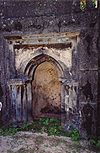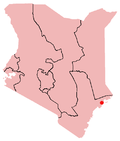- Manda Island
-
Lamu Archipelago Map of Kenya showing the islands Lamu Island Lamu Town †•
Shela
Matondoni
KipanganiManda Island Manda Town ‡
Takwa ‡
Manda AirportPate Island Faza †
Pate Town
--Rulers of Pate
---- Bwana Mkuu
---- Bwana Tamu
---- Fumo Madi
Siyu
Kizingitini
Shanga ‡Kiwayu Island † Administrative Centre
‡ Archaeological site
• World Heritage SiteManda is an island of the Lamu Archipelago of Kenya, known for the prosperous 9th century ports of Takwa and Manda town. The island is now linked by ferry to Lamu and is home to Manda Airport, while Manda Toto island lies to its west. The island is separated from the mainland by the narrow Mkanda channel.
Both Manda town and Takwa were probably abandoned due to lack of water in the first half of the 19th century. In the 1960s the Kenya Department of Agriculture recommended building several concrete catchments called jabias to capture rain water on the island. Two jabias were built and many families moved onto the island, farming maize, cassava, simsim and cotton. [1]
Contents
Manda town
History
The Manda town ruins (by the coast on the NW side), were first explored by the archaeologist Neville Chittick in 1965. The town owed its origins in the 9th and 10th centuries to trade with the Persian Gulf. The chief trading commodity was probably elephant ivory; mangrove poles were probably also important. From the earliest period the inhabitants of Manda were building with burnt square brick and stone and set with a lime mortar. These building techniques are found only on the coast and on the islands of Kenya; they have not been used in the interior of the country [2], whereas the bricks averaging about 18 cm (which "match perfectly ...in measure") are unique for East Africa for this period, and are likely to have been brought in from Sohar, in Oman, initially as ballast in the sailing ships entering the port.[3]From the mid-9th century to the early 11th century buildings were also constructed from coral known as coral rag cut from dead coral reefs.
The large scale excavations in 1966, 1970 and 1978, revealed an unrivalled prosperity for the period and include Chinese porcelain dating from the ninth century onward, Islamic pottery and glass, and local pottery datable by the associated imports. The most striking feature of the town are large sea walls built in a period between the 9th century to the 13th century.[4] Running parallel with the sea with returns running inland, these walls built from large coral blocks are deduced to have been constructed partly to reclaim sections of the shore, and partly to consolidate the edges of the peninsula.
At the heights of its power the town covered some 40 acres (160,000 m2) and its population is estimated to have been about 3,500.[5] Manda prospered until the 13th century when it began to decline.
Takwa
 Takwa Ruins Mihrab
Takwa Ruins Mihrab Main article: Takwa
Main article: TakwaThe Takwa Ruins was a 1500-1700 town, and it was designated a Kenyan National Monument in 1982.
Manda Airport
Main article: Manda AirportManda Airport is the only airport in the Lamu Archipelago.
Notes
- ^ Martin, 1973, p. 27
- ^ Chittick, 1984, p. 217
- ^ Chittick, 1984, p. 15
- ^ Chittick, 1984, p.11-12. Chittick defines 6 periods: Mid-9th to early 11th century, Mid-11th to late 13th century, late 13th to 14th century, 15th and early 16th century, Mid-16th to 17th century, and Post-seventeenth century.
- ^ Martin, 1973, p. 26
References
- Chittick, Neville: MANDA: Excavations at an Island Port on the Kenya Coast. British Institute In Eastern Africa, 1984 ISBN 0-500-97006-8
- Martin, Chryssee MacCasler Perry and Esmond Bradley Martin: Quest for the Past. An historical guide to the Lamu Archipelago. 1973.
Further reading
- Wilson, Thomas H.: Takwa: An Ancient Swahili Settlement of the Lamu Archipelago. Kenya Museum Society.
Categories:- Lamu Archipelago
- Populated places in Coast Province
- Archaeological sites in Kenya
- Islands of Kenya
- Former populated places in Kenya
Wikimedia Foundation. 2010.

